Incorporating Virtual Reality Technology in Safety Training Solution for Construction Site of Urban Cities
Abstract
1. Introduction
2. Methods
2.1. 3D Modelling
2.2. Simulation Platform
2.3. Survey Design
3. Training Experiment Results
3.1. Training Performance
3.2. Feedback from Participants
4. Discussion
4.1. Participant Perception
4.2. Participant Performance Regarding 3D Motion Sickness
4.3. Implications
4.4. Limitations
5. Conclusions
Author Contributions
Funding
Institutional Review Board Statement
Informed Consent Statement
Data Availability Statement
Acknowledgments
Conflicts of Interest
References
- Safe Work Australia. WHS Statistics Australia. Available online: https://www.safeworkaustralia.gov.au/taxonomy/term/17 (accessed on 5 November 2020).
- Safe Work Australia. Key Work Health and Safety Statistics. Available online: https://www.safeworkaustralia.gov.au/doc/key-work-health-and-safety-statistics-australia-2020 (accessed on 5 November 2020).
- Garrett, J.W.; Teizer, J. Human factors analysis classification system relating to human error awareness taxonomy in construction safety. J. Constr. Eng. Manag. 2009, 135, 754–763. [Google Scholar] [CrossRef]
- Burke, M.J.; Sarpy, S.A.; Smith-Crowe, K.; Chan-Serafin, S.; Salvador, R.O.; Islam, G. Relative effectiveness of worker safety and health training methods. Am. J. Public Health 2006, 96, 315–324. [Google Scholar] [CrossRef] [PubMed]
- Goetsch, D. Construction Safety & Health, 2nd ed.; Pearson: Boston, MA, USA, 2013. [Google Scholar]
- Bhoir, S.; Esmaeili, B. State-of-the-art review of virtual reality environment applications in construction safety. In Proceedings of the AEI 2015, Milwaukee, WI, USA, 24–27 March 2015. [Google Scholar]
- Perlman, A.; Sacks, R.; Barak, R. Hazard recognition and risk perception in construction. Saf. Sci. 2014, 64, 22–31. [Google Scholar] [CrossRef]
- Moore, H.F.; Eiris, R.; Gheisari, M.; Esmaeili, B. Hazard Identification Training Using 360-Degree Panorama vs. Virtual Reality Techniques: A Pilot Study. In Proceedings of the ASCE International Conference on Computing in Civil Engineering 2019, Atlanta, GA, USA, 17–19 June 2019. [Google Scholar]
- Zuluaga, C.M.; Namian, M.; Albert, A. Impact of training methods on hazard recognition and risk perception in construction. In Proceedings of the Construction Research Congress, San Juan, Puerto Rico, 31 May–2 June 2016; pp. 2861–2871. [Google Scholar]
- Kuligowski, E.D.; Walpole, E.H.; Lovreglio, R.; McCaffrey, S. Modelling evacuation decision-making in the 2016 Chimney Tops 2 fire in Gatlinburg, TN. Int. J. Wildland Fire 2020, 29, 1120–1132. [Google Scholar] [CrossRef]
- Lovreglio, R.; Duan, X.; Rahouti, A.; Phipps, R.; Nilsson, D. Comparing the effectiveness of fire extinguisher virtual reality and video training. Virtual Real. 2020. [Google Scholar] [CrossRef]
- Dickinson, J.K.; Woodard, P.; Canas, R.; Ahamed, S.; Lockston, D. Game-based trench safety education: Development and lessons learned. J. Inf. Technol. Constr. 2011, 16, 119–134. [Google Scholar]
- Guo, H.; Li, H.; Chan, G.; Skitmore, M. Using game technologies to improve the safety of construction plant operations. Accid. Anal. Prev. 2012, 48, 204–213. [Google Scholar] [CrossRef]
- Sacks, R.; Perlman, A.; Barak, R. Construction safety training using immersive virtual reality. Constr. Manag. Econ. 2013, 31, 1005–1017. [Google Scholar] [CrossRef]
- Pedro, A.; Le, Q.T.; Park, C.S. Framework for integrating safety into construction methods education through interactive virtual reality. J. Prof. Issues Eng. Educ. Pract. 2016, 142, 04015011. [Google Scholar] [CrossRef]
- Feng, Z.; González, V.A.; Amor, R.; Spearpoint, M.; Thomas, J.; Sacks, R.; Lovreglio, R.; Cabrera-Guerrero, G. An immersive virtual reality serious game to enhance earthquake behavioral responses and post-earthquake evacuation preparedness in buildings. Adv. Eng. Inform. 2020, 45, 101118. [Google Scholar] [CrossRef]
- Xu, Z.; Zou, X.; Oh, T.; Vu, H.L. Studying freeway merging conflicts using virtual reality technology. J. Saf. Res. 2020, in press. [Google Scholar] [CrossRef]
- Bric, J.D.; Lumbard, D.C.; Frelich, M.J.; Gould, J.C. Current state of virtual reality simulation in robotic surgery training: A review. Surg. Endosc. 2016, 30, 2169–2178. [Google Scholar] [CrossRef] [PubMed]
- Thomsen, A.S.S.; Bach-Holm, D.; Kjærbo, H.; Højgaard-Olsen, K.; Subhi, Y.; Saleh, G.M.; Park, Y.S.; la Cour, M.; Konge, L. Operating room performance improves after proficiency-based virtual reality cataract surgery training. Ophthalmology 2017, 124, 524–531. [Google Scholar] [CrossRef] [PubMed]
- Berg, L.P.; Vance, J.M. Industry use of virtual reality in product design and manufacturing: A survey. Virtual Real. 2017, 21, 1–17. [Google Scholar] [CrossRef]
- Amaguaña, F.; Collaguazo, B.; Tituaña, J.; Aguilar, W.G. Simulation system based on augmented reality for optimization of training tactics on military operations. In Augmented Reality, Virtual Reality and Computer Graphics; Springer: Cham, Switzerland, 2018; pp. 394–403. [Google Scholar]
- Hamid, A.R.A.; Yusof, W.Z.W.; Singh, B.S.B.J. Hazards at construction sites. In Proceedings of the 5th Asia-Pacific Structural Engineering and Construction Conference (APSEC 2003), Johor Bahru, Malaysia, 26–28 August 2003. [Google Scholar]
- Oculus.com. 2018. Oculus Quest: Our Most Advanced All-In-One VR Headset|Oculus. Available online: https://www.oculus.com/quest (accessed on 5 December 2018).
- Johnholland.com.au. Health & Safety: John Holland. Available online: https://www.johnholland.com.au/our-approach/health-safety/ (accessed on 5 November 2018).
- Buyuksalih, I.; Bayburt, S.; Buyuksalih, G.; Baskaraca, A.P.; Karim, H.; Rahman, A.A. 3D Modelling and Visualization Based on the Unity Game Engine–Advantages and Challenges. ISPRS Ann. Photogramm. Remote. Sens. Spat. Inf. Sci. 2017, 4, 161. [Google Scholar] [CrossRef]
- Docs.unity3d.com. Unity—Manual: Multiplayer Overview. Available online: https://docs.unity3d.com/Manual/UNetOverview.html (accessed on 12 December 2018).
- Lunkes, R.J.; Rosa, F.S.; Monteiro, J.J.; Bortoluzzi, D.A. Interactions among Environmental Training, Environmental Strategic Planning and Personnel Controls in Radical Environmental Innovation. Sustainability 2020, 12, 8748. [Google Scholar] [CrossRef]
- Olmos-Gómez, M.C.; Luque-Suárez, M.; Mohamed-Mohamed, S.; Cuevas-Rincón, J.M. Validation of the Smart City as a Sustainable Development Knowledge Tool: The Challenge of Using Technologies in Education during COVID-19. Sustainability 2020, 12, 8384. [Google Scholar] [CrossRef]
- Kennedy, R.S.; Lane, N.E.; Berbaum, K.S.; Lilienthal, M.G. Simulator sickness questionnaire: An enhanced method for quantifying simulator sickness. Int. J. Aviat. Psychol. 1993, 3, 203–220. [Google Scholar] [CrossRef]
- Van Der Laan, J.D.; Heino, A.; De Waard, D. A simple procedure for the assessment of acceptance of advanced transport telematics. Transp. Res. Part C Emerg. Technol. 1997, 5, 1–10. [Google Scholar] [CrossRef]
- Nunally, J.; Bernstein, L. Psychometric Theory; MacGrow-Hill Higher: New York, NY, USA, 1994. [Google Scholar]
- Carter, G.; Smith, S.D. Safety hazard identification on construction projects. J. Constr. Eng. Manag. 2006, 132, 197–205. [Google Scholar] [CrossRef]
- Stephenson, R.S.; Atkinson, A.; Kottas, P.; Perde, F.; Jafarzadeh, F.; Bateman, M.; Iaizzo, P.A.; Zhao, J.; Zhang, H.; Anderson, R.H.; et al. High resolution 3-dimensional imaging of the human cardiac conduction system from microanatomy to mathematical modeling. Sci. Rep. 2017, 7, 7188. [Google Scholar] [CrossRef] [PubMed]
- Breuer, A.; Janetschek, H.; Malerba, D. Translating Sustainable Development Goal (SDG) Interdependencies into Policy Advice. Sustainability 2019, 11, 2092. [Google Scholar] [CrossRef]
- Hegre, H.; Petrova, K.; von Uexkull, N. Synergies and Trade-Offs in Reaching the Sustainable Development Goals. Sustainability 2020, 12, 8729. [Google Scholar] [CrossRef]
- Fokaides, P.A.; Apanaviciene, R.; Černeckiene, J.; Jurelionis, A.; Klumbyte, E.; Kriauciunaite-Neklejonoviene, V.; Pupeikis, D.; Rekus, D.; Sadauskiene, J.; Seduikyte, L.; et al. Research Challenges and Advancements in the field of Sustainable Energy Technologies in the Built Environment. Sustainability 2020, 12, 8417. [Google Scholar] [CrossRef]

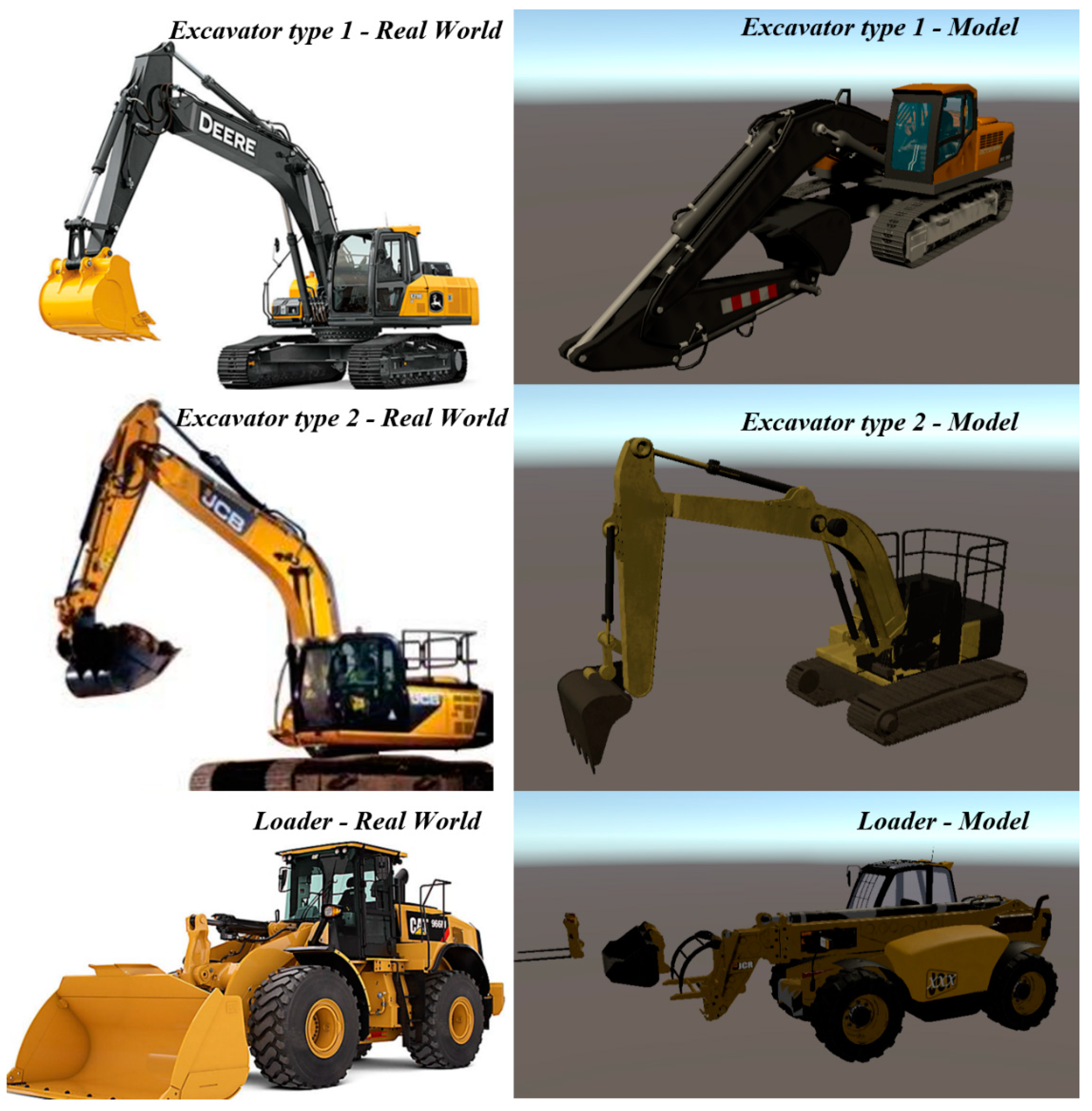
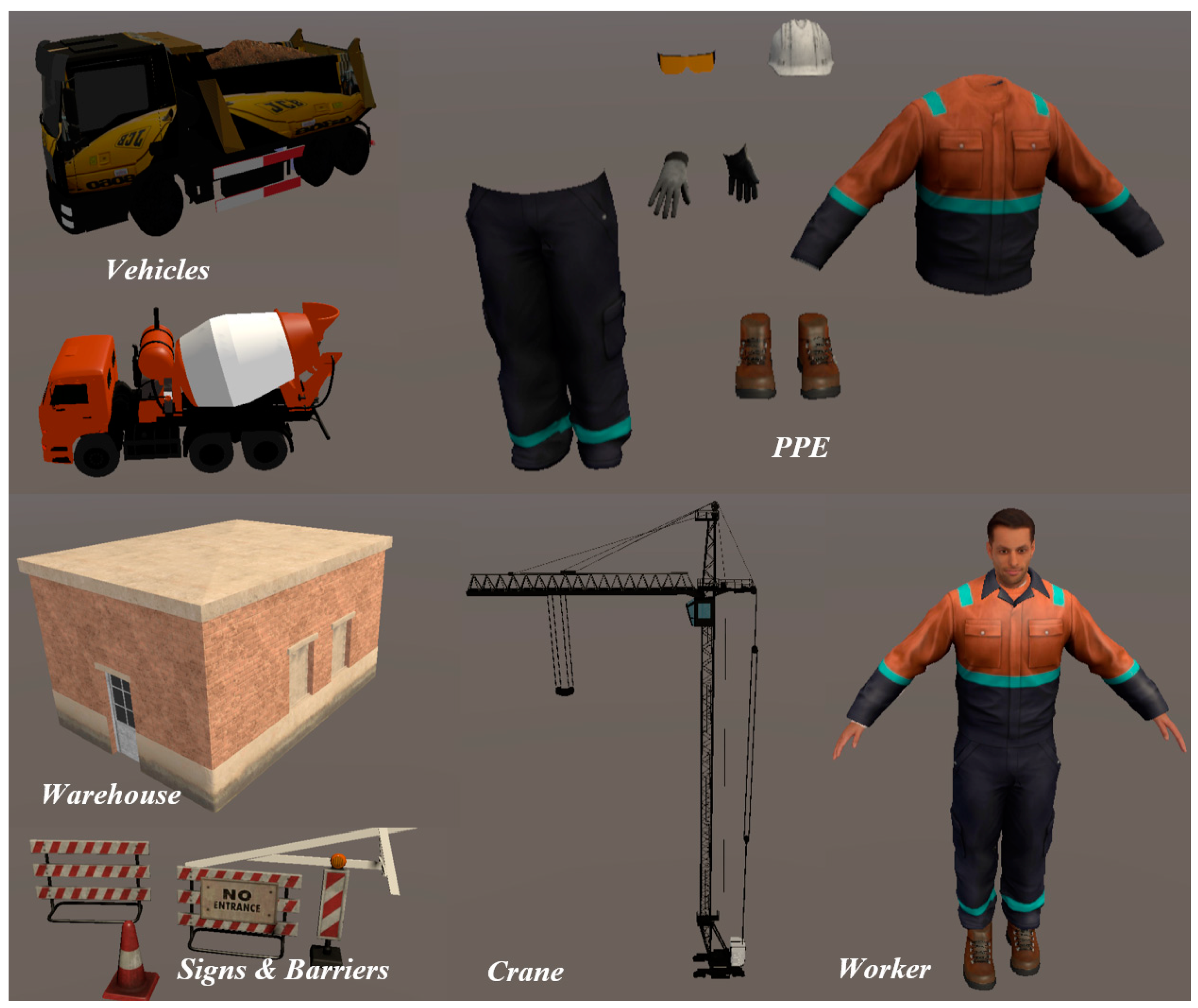
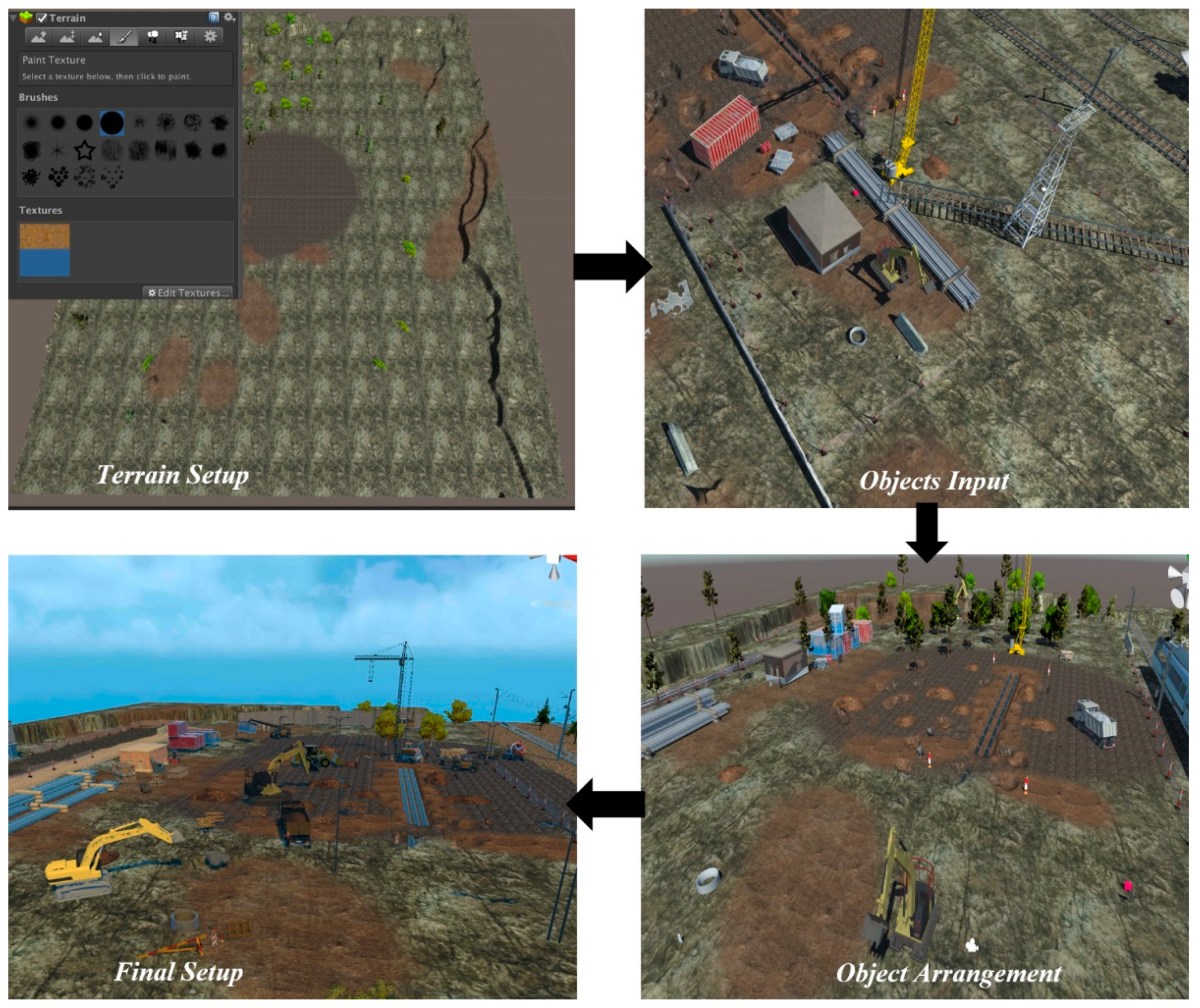
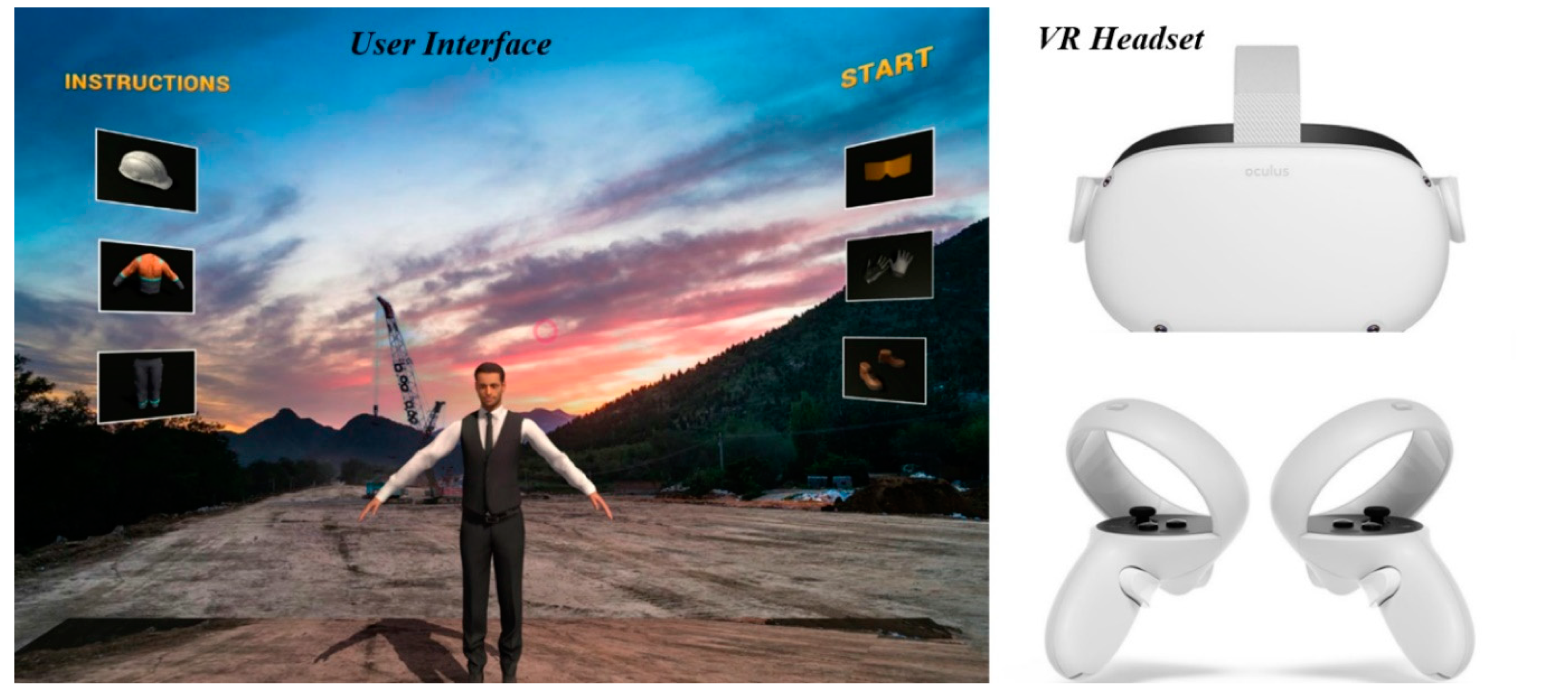
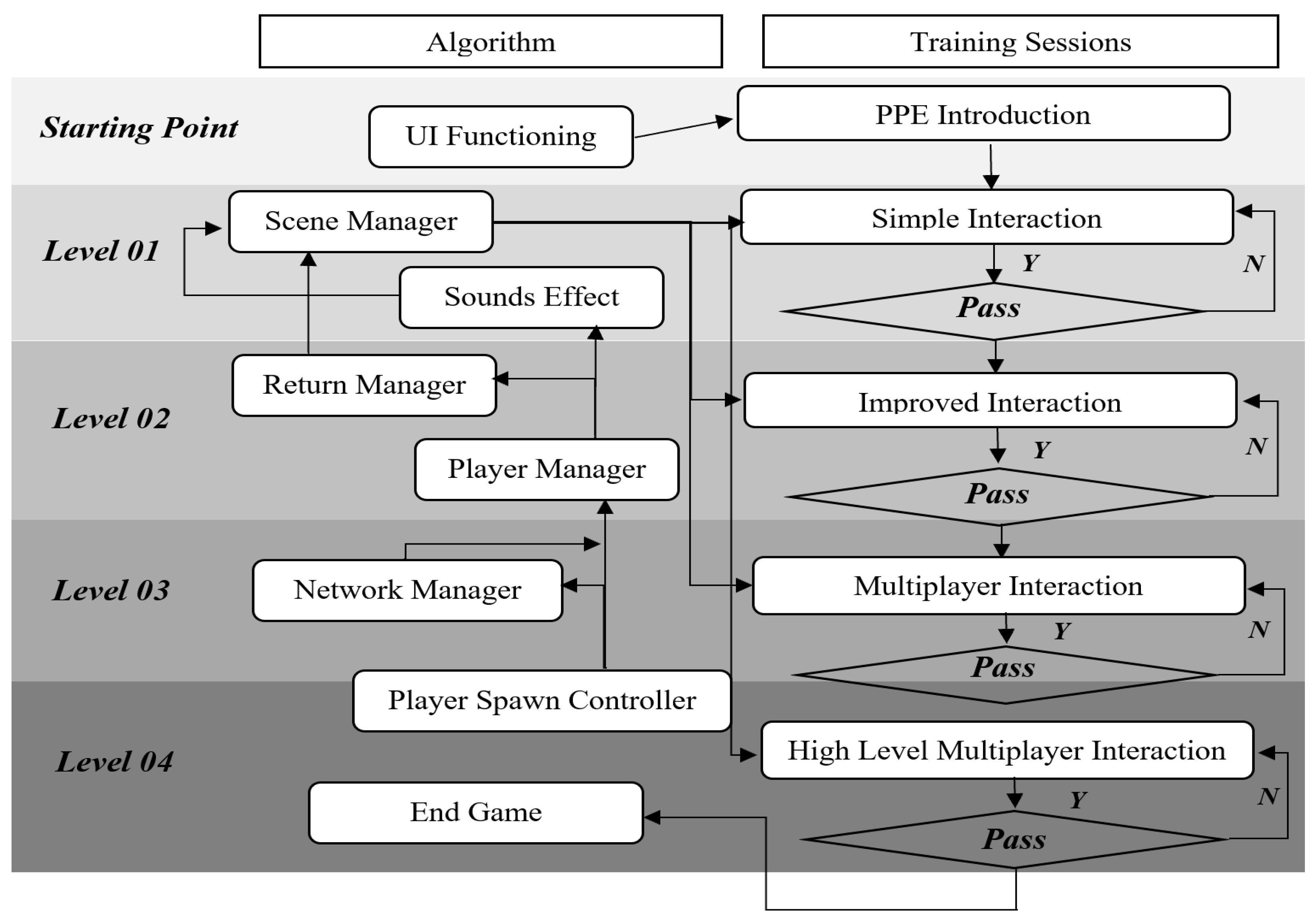
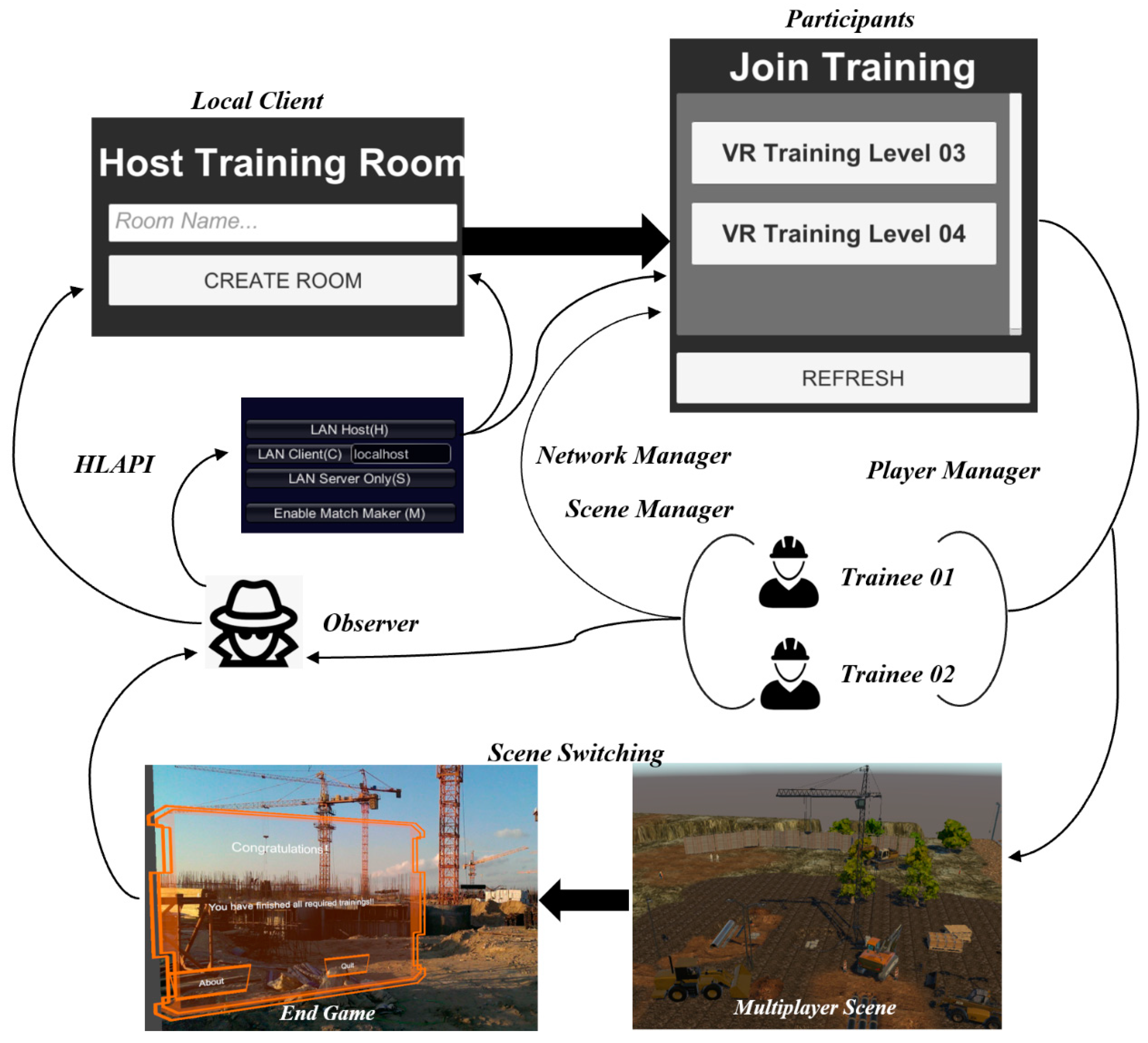


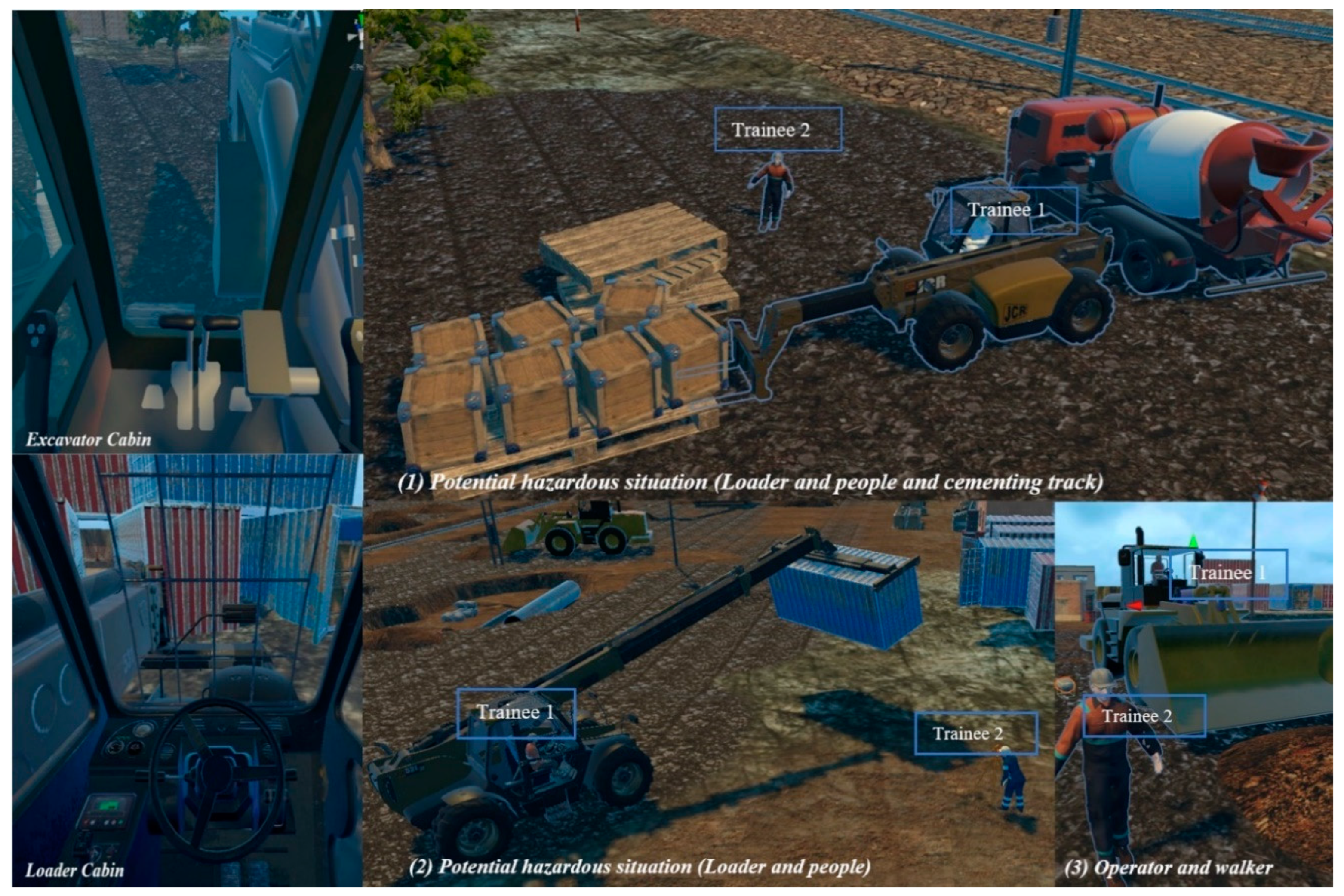
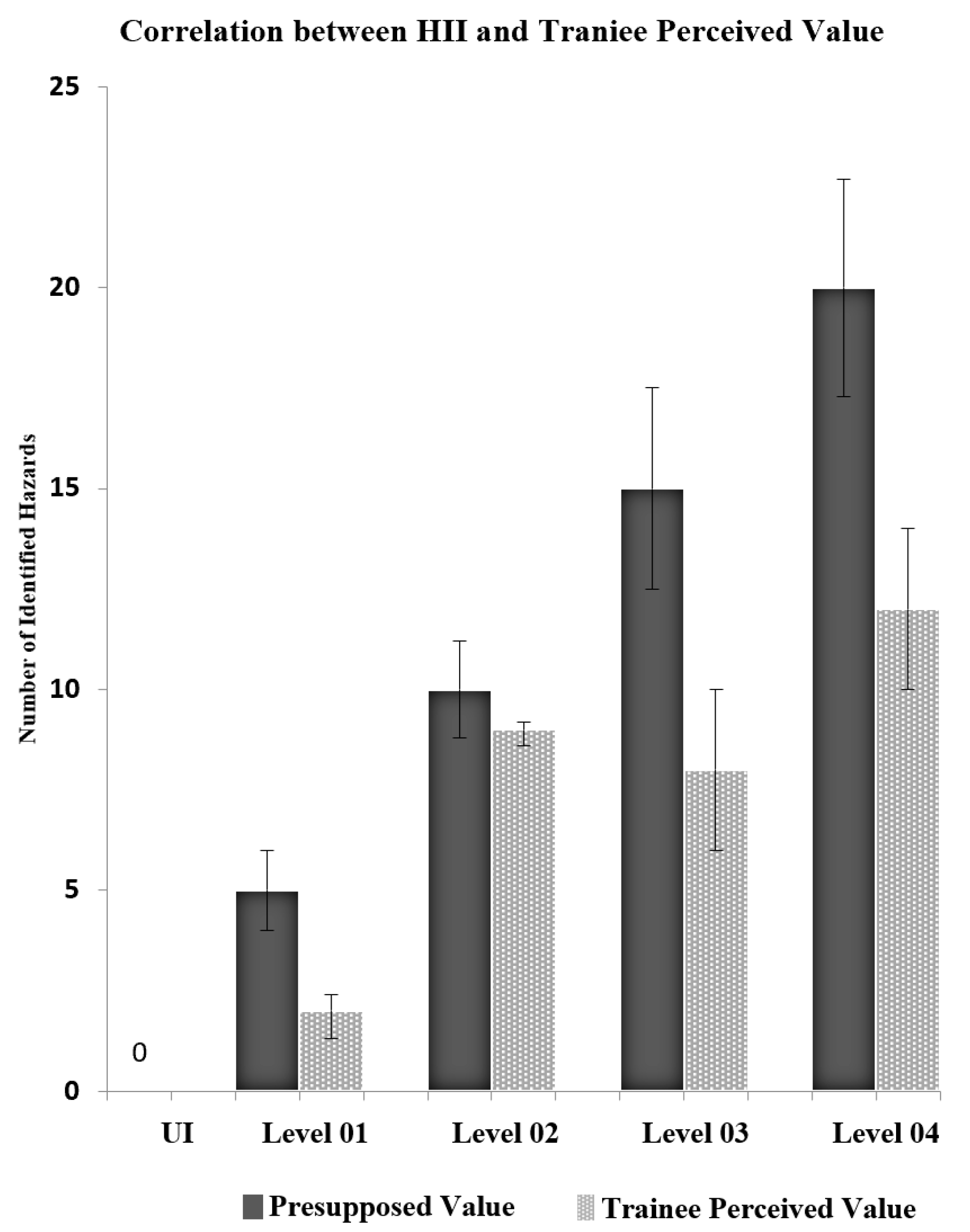
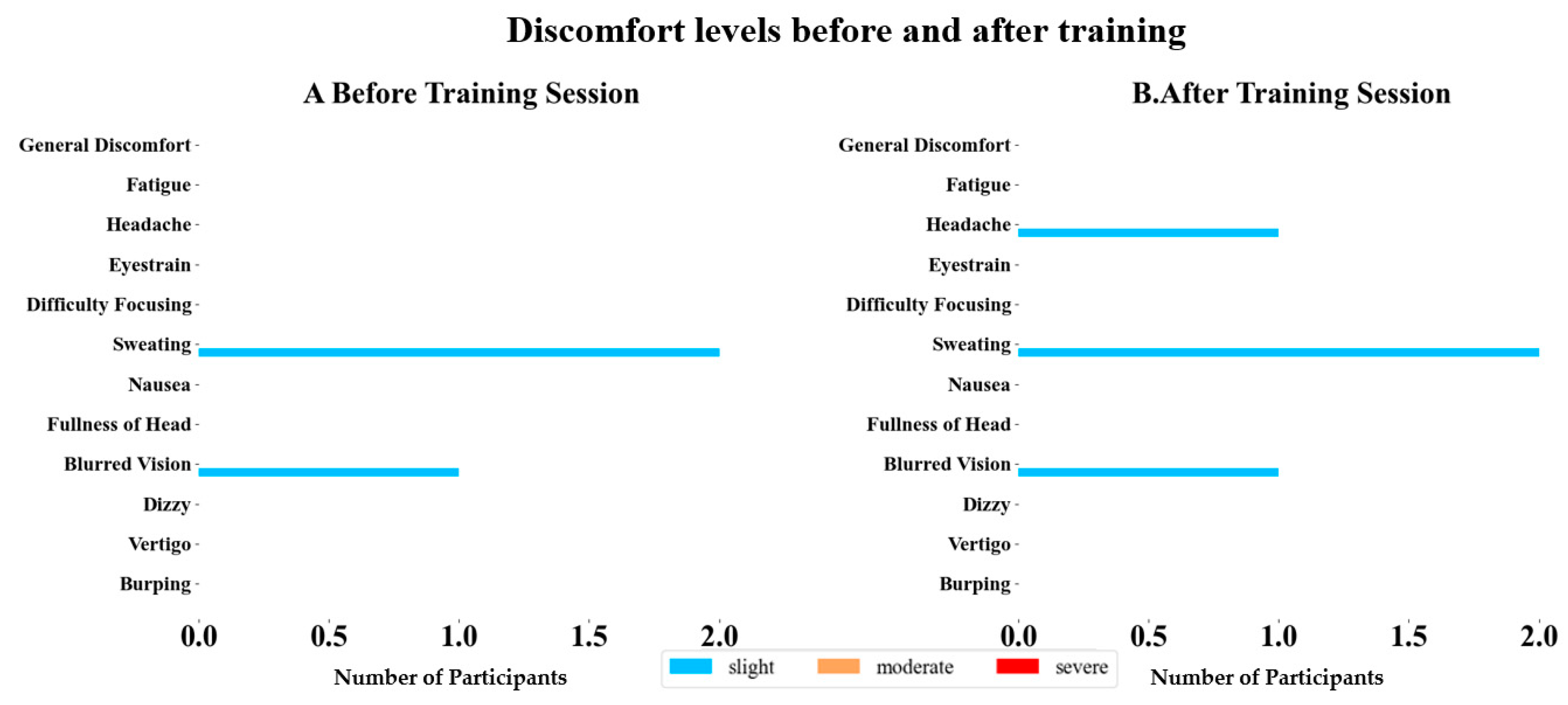
| Training Level | Main Features | Requirements for Passing |
|---|---|---|
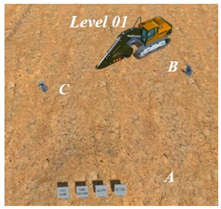 | Relatively smooth ground. It contains only single running machinery, which is used for players to get familiar with the VR environment. The player must inform the machinery operator correctly to pass this level. This is the simplest level. | The trainee would be spawned at point A and is expected to move to point B after reading through the instruction. The player is required to move to point C securely, e.g., notify the operator of the excavator to stop working or move from A to C and maintain enough distance from the machinery. |
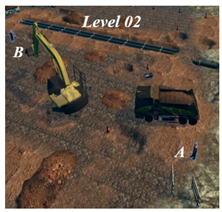 | A few gaps on the ground. An excavator and a truck are running simultaneously, and the player has to make sure not to walk on the vehicles’ moving track or inform the operators to pass this level. Few objects are arranged at this level. | The trainee would be spawned at point A and is expected to navigate to point B securely, e.g., waiting for the truck to stop and notify the operator of the excavator to stop. Getting hurt or staying in the same place for over 1 min would be considered a failure. |
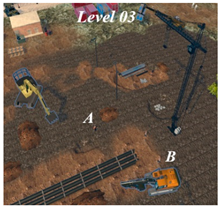 | Multiplayer scene with several trenches on the ground. All the loaders, excavators, and cranes are working together. Fragment of bricks may drop from the tower crane. The player must avoid all potential hazards and pass this level without getting hurt. | Trainees would be spawned at point A and point B. They can explore the whole scene at this level. Players will be removed after 5 min, and they are expected to keep the other safe. They would fail if they get injured or stay in the same place over 1 min. |
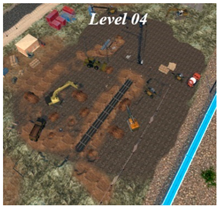 | Multiplayer scene with several trenches on the ground. All machinery (including the train) is working together. Players would be randomly assigned to any sites, and they have to work collaboratively to pass the training. For example, one could act as the operator, while the other stands in the blind zone. | Trainees would be randomly spawned into the scene. They would act as a machinery operator and on-site worker. They would be removed after 5 min and 30 s, and they are expected to keep the other safe. For failing, same conditions in level 03 applied. |
| Survey Topic | Application | Questions | Responses |
|---|---|---|---|
| Demographics | Given before the training | Gender; age; working experience (years) Average working time per day (hours) Injured times (can be specified) Previous experience with VR | In numbers “<6”–“>8” “0”–“>5” “0”–“>10” |
| Simulator discomfort | Given before and after the training | Evaluation subscales were used to assess general discomforts such as fatigue, headache, eyestrain, sweating, nausea, dizzy, etc. | Slight, moderate, and severe. |
| Perception of the VR training platform | Given after the training | Whether the training sessions are more impressive; whether nervousness was experienced; whether it was easy to move around; whether it is easier to getting hurts in VR environment; whether lost; whether the VR system provided good visualization | The 5-point Likert scale (“strongly disagree 1” to “strong agree 5”). |
| Simulating realism | Given after the training | Whether the decent visualization was provided; whether it helped improve safety awareness; simulator realism. | “strongly disagree 1” to “strong agree 5”; “very poor (0)” to “excellent (5)”. |
| Characteristic | Percentage (%) | Characteristic | Percentage (%) |
|---|---|---|---|
| Gender | Average working time per day (h) | ||
| Male | 100 | Less than 6 | 0 |
| Female | 0 | 6–8 | 80 |
| Age | More than 8 | 20 | |
| 18–25 | 20 | Injured times | |
| 26–40 | 80 | 0–1 | 80 |
| Working Experience (years) | 1–2 | 20 | |
| 0–1 | 70 | Experience with VR | |
| 1–2 | 30 | 0 | 60 |
| More than 2 | 0 | 1–2 | 30 |
| More than 3 | 10 |
| Perception of Training Sessions | Traditional | Virtual Reality | ||||
|---|---|---|---|---|---|---|
| M 1 | SD 2 | M 1 | SD 2 | |||
| Whether sessions are impressive | 1.50 | 0.50 | 0.60 | 4.50 | 0.71 | 0.64 |
| Whether felt nervous | 1.00 | 0.00 | 2.00 | 1.12 | ||
| Whether it was easy to move | 4.13 | 0.59 | 3.63 | 1.41 | ||
| Whether got hurts | 1.00 | 0.00 | 3.63 | 1.41 | ||
| Whether lost | 1.13 | 0.33 | 3.75 | 1.30 | ||
| VR Simulating Realism | M 1 | SD 2 | |
|---|---|---|---|
| Good Visualization | 3.90 | 0.83 | 0.65 |
| Difficult to Operate | 2.00 | 1.18 | |
| Improve Safety Awareness | 4.00 | 1.00 | |
| Good Training Tool | 3.40 | 1.02 | |
| More Impressive | 4.10 | 0.83 |
Publisher’s Note: MDPI stays neutral with regard to jurisdictional claims in published maps and institutional affiliations. |
© 2020 by the authors. Licensee MDPI, Basel, Switzerland. This article is an open access article distributed under the terms and conditions of the Creative Commons Attribution (CC BY) license (http://creativecommons.org/licenses/by/4.0/).
Share and Cite
Xu, Z.; Zheng, N. Incorporating Virtual Reality Technology in Safety Training Solution for Construction Site of Urban Cities. Sustainability 2021, 13, 243. https://doi.org/10.3390/su13010243
Xu Z, Zheng N. Incorporating Virtual Reality Technology in Safety Training Solution for Construction Site of Urban Cities. Sustainability. 2021; 13(1):243. https://doi.org/10.3390/su13010243
Chicago/Turabian StyleXu, Zheng, and Nan Zheng. 2021. "Incorporating Virtual Reality Technology in Safety Training Solution for Construction Site of Urban Cities" Sustainability 13, no. 1: 243. https://doi.org/10.3390/su13010243
APA StyleXu, Z., & Zheng, N. (2021). Incorporating Virtual Reality Technology in Safety Training Solution for Construction Site of Urban Cities. Sustainability, 13(1), 243. https://doi.org/10.3390/su13010243






